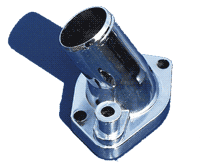Preparing A Tiger To Live In The Arizona Desert
By Cullen Bennett
B9472658
September 15, 1999
"Someone Was Looking Out For Me"
In retrospect, there is one word (actually two words) of caution with
regard to aluminum radiators. That is "galvanic action". Aluminum
from a chemical point of view is on the right side of the periodic element
chart. What this means is that it is very susceptible to corrosion (in simple
terms). When used in a system with other metals, especially brass and cast
iron, aluminum ends up being the "sacrificial" metal that gets
eaten away by the exodus of electrons when they are united through an
electrolyte (i.e. cooling solution with contaminants). Several years after
I had installed my aluminum radiator, I was replacing the thermostat when
I found that the housing for the thermostat was almost completely corroded
away on the inside. A shock of terror flashed through me. What has it done
to my $450 radiator. I quickly pulled a hose off and peered inside with a
flashlight, only to find a shiny reflection bouncing bask at me.
<Flash-Back>
When I had installed the new radiator, I had gone down to a local auto parts supply house (PEP Boys) and found a bright shiny new thermostat housing that looked like it was chrome plated to fit the Tiger. Little did I know that the little item would be saving the life of my new radiator.
Since I found no damage, I was momentarily perplexed. What could
the housing be made out of that has a lower electronegativity than aluminum.
(basic engineering thought process at work) I took a hack saw to the housing
and cut off a piece. I took it into work the next day and told my story to
the metallurgist at the company where I work. He said "no problem"
and popped it into a scanning electron microscope with elemental readout
( this thing presents a spectrum analysis of all the materials that make
up the sample by percentage). In about 5 minutes the diagnostic printout
was sliding out of the machine. The housing was 97% zinc and 2% aluminum
and the remaining 1% was distributed across "other" materials,
most likely contamination elements. We walked over to the big periodic
chart on the wall and found, sure enough, zinc is in the column next to
aluminum, with one additional electron available to be a donor. So, whether
this part was made out of zinc just because it is cheaper to cast and
manufacture (in Taiwan) or it was done intentionally with someone supposing
it would be used with aluminum in a harsh environment, we will never be
known. All I can say is "Thank You Lord" for small miracles. I
always heard he looked out for the impaired and the ignorant (me). In
retrospect, the thermostat housing costs somewhere in the neighborhood of
$12 and for my money it is the best insurance (even on an annual basis)
that you can buy to protect your aluminum radiator. Of course, a new
batch of distilled water and antifreeze, with lubricants and neutralizers
doesn't hurt either.

Daytona Accessories #9844 (Ford 289-351W) MR. Gasket Co. 8700 Brookport Rd. Cleveland, OH 44129
While on the topic of thermostats, several years ago I conducted an
experiment on about 5 different thermostats (all at different
"operating" points). This was done on the kitchen stove in a pan
of water using a calibrated thermocouple to measure the stirred water
temperature. What I found was that ALL of the units just started opening
at the "rated operating point" and required an additional 15
degrees (F) to come to a fully open position. The physical position was
somewhat linear between these temperatures. The "system" overall
operating should be somewhere within this region (providing there is no
other limitation). I have read a recommendation to drill 4 holes 0.125"
at 90 degrees separation on perimeter of housing to allow for air bubbles
to pass through as well as establish a "baseline " flow for
the liquid. They are not large enough to affect the thermostat operation,
in fact they improve the sensing action of the thermostat by allowing
some minimal coolant flow.
 **
**
